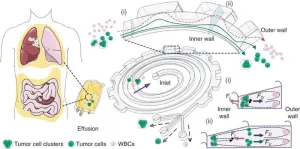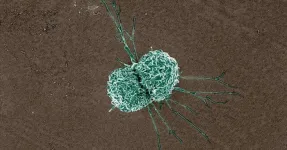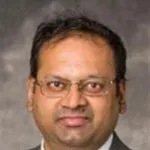(Press-News.org) Researchers have unveiled a microfluidic device that significantly improves the separation of tumor cells and clusters from malignant effusions. This novel technology promises to advance the diagnosis and treatment monitoring of cancer by enabling the high-throughput, continuous-flow ternary separation of single tumor cells, tumor cell clusters, and white blood cells (WBCs) from clinical pleural or abdominal effusions.
Understanding the nature of malignant effusions, teeming with tumor cells and clusters, is critical in comprehending the breadth of cancer's impact. The significant role of tumor clusters, with their heightened potential for metastasis compared to individual cells, cannot be overstated in the context of comprehensive cancer care. While traditional techniques have shown adeptness in isolating single tumor cells, they often fall short when it comes to tumor clusters, thus limiting the scope of clinical research. The evolution of microfluidic technologies has introduced high-throughput, label-free approaches for the separation of these cells, leveraging their physical characteristics for more precise analyses. However, the challenges presented by tumor cell clusters—primarily their rarity and fragility—call for innovative solutions to ensure their efficient yet careful separation, maintaining their viability for downstream applications.
In response to this challenge, a team of researchers from Southeast University has unveiled a microfluidic device, designed to achieve the precise separation of tumor entities with unprecedented efficiency. These findings were detailed in an article (DOI: 10.1038/s41378-024-00661-0) published on March 12, 2024, in Microsystems & Nanoengineering. This research introduces a device that skillfully integrates slanted spiral channels with periodic contraction-expansion arrays.
This design utilizes inertial forces to adeptly separate single tumor cells, tumor cell clusters, and WBCs from clinical samples of pleural or abdominal effusions—key indicators of cancer metastasis. Operating at a brisk flow rate of 3500 µL/min, the device not only manages large volumes efficiently but also ensures an exceptionally high degree of separation accuracy. With over 94% of WBCs effectively removed, the recovery of more than 97% of tumor cells and the preservation of over 90% of vital tumor cell clusters, this technology heralds a new era in cancer diagnostics, facilitating early detection, prognosis evaluation, and the monitoring of treatment outcomes.
Professor Nan Xiang, the study's lead author, remarked, "Our device represents a substantial advancement in the analysis of malignant effusions. By efficiently isolating tumor cell clusters, known for their considerable metastatic potential, we're forging new pathways for the early detection and treatment of cancer."
This innovation marks a significant milestone in the realm of cancer diagnostics, enhancing the efficiency and throughput of tumor cell and cluster separation from malignant effusions. As such, it sets the stage for more nuanced cancer detection, ongoing monitoring, and the personalization of treatment strategies, heralding a promising future for cancer care.
###
References
DOI
10.1038/s41378-024-00661-0
Original Source URL
https://doi.org/10.1038/s41378-024-00661-0
Funding information
This research was supported by the National Natural Science Foundation of China (52375562, 51875103, and 81727801), the Natural Science Foundation of Jiangsu Province (BK20190064), and the ‘333’ Project of Jiangsu Province.
About Microsystems & Nanoengineering
Microsystems & Nanoengineering is an online-only, open access international journal devoted to publishing original research results and reviews on all aspects of Micro and Nano Electro Mechanical Systems from fundamental to applied research. The journal is published by Springer Nature in partnership with the Aerospace Information Research Institute, Chinese Academy of Sciences, supported by the State Key Laboratory of Transducer Technology.
END
Next-gen lab chip transforms cancer detection: triple-threat cell sorting unveiled
2024-04-11
ELSE PRESS RELEASES FROM THIS DATE:
NCCN 2024 Annual Conference shares cancer care updates for practical, immediate use in practice
2024-04-11
PLYMOUTH MEETING, PA [April 11, 2024] — The National Comprehensive Cancer Network® (NCCN®)—an alliance of leading cancer centers—hosted more than 1,700 oncology professionals during the NCCN 2024 Annual Conference on April 5-7. The yearly meeting includes opportunities for care providers to interact with world-renowned specialists on the latest evidence-based expert consensus recommendations for delivering high quality, patient-centered cancer care. Sessions focused on practical applications for improving care at every level, including clinical and administrative ...
Genetic underpinnings of environmental stress identified in model plant
2024-04-11
Plants can be temperamental. Even weeds along the side of highways or pushing their way up in the cracks of concrete sidewalks can get stressed out by dehydration, cold, excess salt and more. Researchers at Hiroshima University have identified 14 genes that thale cress — a plant commonly used in genetic investigations since its genome is well documented — express more when responding to five specific stressors, as well as eight genes that the plant suppresses.
They published their results on March 22 in Frontiers in Plant Science.
“Abiotic stresses — as opposed to biotic stresses like pests or disease — such as drought, salinity and cold negatively ...
This outdated diabetes drug still has something to offer
2024-04-11
Thiazolidinediones (TZDs) are a class of drug that can be used to treat type 2 diabetes by reversing insulin resistance, one of the main hallmarks of the disease. While TZDs were extremely popular in the 1990’s and early 2000’s, they have fallen out of use among physicians in recent decades because they were discovered to cause unwanted side effects, including weight gain and excess fluid accumulation in body tissues.
Now, researchers at University of California San Diego School of Medicine are ...
Developing best practices for human-AI collaboration in engineering design
2024-04-11
As artificial intelligence is inevitably woven into the workplace, teams of humans will increasingly collaborate with robots on complex design problems, such as those in the auto, aviation, and space industries.
“Right now, design is mainly done by humans, and it’s based on their expertise and intuitive decision-making, which is learned over time,” says A. Emrah Bayrak, an assistant professor of mechanical engineering and mechanics in Lehigh University’s P.C. Rossin College of Engineering and Applied Science. “Usually, ...
Novel CT exam reduces need for invasive artery treatment
2024-04-11
OAK BROOK, Ill. – A new study showed that a non-invasive imaging test can help identify patients with coronary artery blockage or narrowing who need a revascularization procedure. The findings were published as a Special Report in Radiology: Cardiothoracic Imaging, a journal of the Radiological Society of North America (RSNA).
Doctors use coronary CT angiography (CTA) to diagnose narrowed or blocked arteries in the heart. A CTA exam receives a score from mild (0-1) to moderate (2-3) to severe (4-5). Patients ...
ERC Advanced Grant: 2.5 million euros for Tobias Brixner
2024-04-11
Many people are familiar with the principle of electronic excitation from their physics lessons: electrons in atoms or molecules absorb energy, typically from light, and rise to a higher energy level. This can have various consequences – in photovoltaic technology, the phenomenon ensures that electricity can be generated from sunlight.
Measuring electronic excitation according to scientific standards and investigating how excited electrons influence each other is a real challenge: “Electronic excitation and the subsequent processes take place extremely quickly, many things happen simultaneously“, explains Tobias Brixner, Chair of Physical Chemistry ...
Proud seafarers have strong doubts about the safety of autonomous ships
2024-04-11
The maritime profession is among the world’s oldest professions, and today’s shipping is based on long and proud traditions. Professional pride and commitment are often deeply ingrained in seafarers, and for many, the job is more of a way of life. New technologies will bring about major changes in the work of bridge officers, who have the ultimate responsibility on board Norwegian vessels.
Strong doubts about safety
“Bridge officers rely on automated systems that are already found on board, such as advanced autopilot systems. However, there is strong scepticism, almost mistrust, that increased automation and autonomous ...
People who use willpower alone to achieve goals, resist temptation, deemed more trustworthy
2024-04-11
People who use willpower to overcome temptations and achieve their goals are perceived as more trustworthy than those who use strategies that involve external incentives or deterrents – such as swear jars or internet-blocking apps – according to research published by the American Psychological Association.
“The knowledge that people can use external commitment strategies to overcome self-control problems has existed in some form for thousands of years. Since at least the time of Homer and Odysseus, the focus has primarily been on the efficacy of these strategies for the person choosing to engage ...
New study shows effect of socio-economic factors—housing, food, neighborhood—to predict diabetic patients’ risk of heart failure
2024-04-11
CLEVELAND—A recent study by Case Western Reserve University used national data from U.S. military veterans with diabetes to validate and modify a widely accepted model used to predict the risk of heart failure in diabetic patients.
The model, called the WATCH-DM score, is used to predict the likelihood of heart failure in diabetes patients within five years.
But because it overlooks the influence of social determinants of health‚ such as housing, food and a patient’s neighborhood, the researchers used a social deprivation index (SDI), a multi-component summary score, to adjust the WATCH-DM score.
The SDI, introduced by the Robert ...
Mapped: 33 new big game migrations across American West
2024-04-11
RESTON, Va. — A new set of maps that document the movements of ungulates was published today in the fourth volume of the Ungulate Migrations of the Western United States. The maps in this collaborative U.S. Geological Survey report series reveal the migration routes and critical ranges used by ungulates, or hooved mammals, in the western U.S., furthering scientists’ understanding of the geography of big game migrations.
The new volume, “Ungulate Migrations of the Western United States: Volume 4,” documents 33 mule deer, ...








